
In September 2018, my boyfriend, Kubo, and I spent nineteen days traveling 2,300 miles through Iceland in a camper van we affectionately named Carl from KúKú Campers. Because #vanlife is an absolutely amazing way to see and experience Iceland, below follows my comprehensive guide to all things camper van in Iceland… from why you should do it, to the upsides, to the downsides, fuel and cost info, food preparation, where to park it, and packing and general road trip tips. And unlike nearly every other travel blog you will read nowadays, I was NOT compensated, sponsored, or discounted in any way by KuKu Campers for this trip. We paid full price for our rental, and what you are going to read is my honest opinion.
Why a camper van?
For me it was an easy choice: freedom and cost. Even in the shoulder seasons, accommodations can be hard to come by in Iceland, meaning reservations need to be made in advance. However, campgrounds do not require reservations, so there’s no worries about not making it to a specific destination, or if you want to switch things up last minute. Also, by self-driving, you are free to stop wherever, and spend as little or as much time as you want where you stop, unlike tour arrangements. Freedom aside, renting a camper van for my 19-day road trip was simply the cost effective choice since it is vehicle and accommodation in one, and also allowed for us to prepare our own meals (restaurants can very pricey in Iceland!).
Camper vans also help maximize your time. You always have all your stuff with you… no leaving on a tour bus and realizing you didn’t dress appropriately. And let’s say you go on a hike, when you get done and are hungry, you just prepare lunch right there. No getting in a car and hunting down a restaurant and wasting precious time (and daylight if you’re not traveling during the summer months). No worrying about getting to check in at a hotel or guesthouse on time.

Naturally, you could tent camp in Iceland and rent a cheaper car or SUV. However, Icelandic weather is… well, Icelandic weather. It is a very rainy and moist country, and even in the summer the temperatures do not get as hot as many are probably use to at home. I don’t know about you, and props if you’re okay with this, but I have no desire to pack up a soggy tent every morning, and then set up that soggy tent later in the day. And not to mention the wind! I’m from an extremely windy place (Wyoming), and Iceland definitely rivals it in terms of strong winds. A camper van provides solid shelter from the rain, wind, snow, and whatever else Iceland will throw at you. Many have heaters that can be used at night. You’ll be sleeping on something other than the ground, too! Plus there is no set up at the end of the day, you literally pull up and park and you’re ready to cook or sleep.

The Campground Situation
Laws have been passed in Iceland requiring camper vans to park in campgrounds, designated areas, or with on property with permission of the landowner overnight. No just pulling over and parking where ever you want! Luckily campgrounds are plentiful in Iceland (I swear every town has one!), do not require reservations, and are often quite beautiful and located near waterfalls, hiking trails, pools, lava fields, hot pots, and more. Plus it’s quite nice to have a toilet to use, along with showers, sinks, and sometimes cooking facilities! In a country already covered in used, discarded toilet paper due to tourists, do what’s proper and use the campgrounds!

I wrote an entire blog about each of the 17 campgrounds we stayed in during our trip. I included September 2018 prices and amenities. Check it out!

Why KuKu Campers?
I did pretty extensive research into my Iceland trip, including transportation options. I had an acquaintance that rented from KuKu Campers for her trip in 2016, and it seemed to go well, so I had them on my radar. Finally, Kubo and I settled on KuKu Campers about six months before our trip because of their reasonable prices, unlimited mileage (very important for the length of trip we had plan), and the fact that a second driver was free (Kubo did drive the entire time, but it was nice knowing I could’ve hopped behind the wheel and been covered just the same). KuKu Campers can be a little more basic than other pricier rental companies in Iceland, but we weren’t renting a van to hang out in it all day long! Our van had what we needed with no extra frills, which was perfect. And well… they’re a bit kooky and crazy, and that appealed to us!

We selected the “Category B” size van from KuKu Campers, which is a manual, diesel Renault Trafic that seats five and sleeps three. We definitely wanted extra room since we would be spending nearly three weeks on the road, and had enough luggage that extra room would be nice. Plus it was important to have an in-van food prep and cooking space, which the smaller KuKu Campers do not have. We named our van “Carl van Elf,” and he quickly became one of our best friends!
The cost for our 19 day trip was 2508 Euros for the van itself. We took the “Golden Package” for insurance, which included SCDW (“super” collision damage waiver), gravel, and sand/ash insurance at 35 Euros a day. We had a lot of gravel roads in our itinerary thanks to the Westfjords, so we wanted to be fully protected. At the very least, I recommend gravel insurance for everyone. Even paved roads have rocks on them which can get flung up and chip/crack a windshield, which is not covered under the CDW or SCDW policies. We witnessed a somewhat comical road rage argument in the parking lot of Goðafoss, with one driver accusing the other of passing too carelessly and throwing up rocks which caused a large chip in the windshield. Don’t let this be you!
We also rented two camping chairs for 7 Euros each. We used them several times at campgrounds in the evening. Not completely necessary, but cheap enough that we didn’t mind the rental fee for them.
Our van came with a couple of gas cylinders for the stove, and we purchased 3 extra at pick up for 10 Euros each. (We also bought a couple more about halfway through our trip)
All said and done, with van fee, airport pickup and drop-off, insurance, and our extras, it came to 3370 Euros, or roughly $3800 USD. This came out to $200/day. This was still more economical than renting a small SUV and paying for lodging every night (and not to mention food on top of that).

What was your rental process?
I had selected for pick up at Keflavík International Airport since it was frankly the most convenient option, and also to drop off the van at the airport when we were departing. This option cost 60 Euros for the pick up and 100 Euros for the option to leave the van at the airport before departing, though I do believe KuKu Campers is now offering free pick up. Their office is located in Hafnarfjörður, which is about 30 minutes from the airport. Our shuttle arrived around 8:30am, and we shared our ride with a family from Utah.

Upon arriving at KuKu Campers, we immediately began the paperwork and payment process after stashing our luggage on racks outside. We were told how to return the van at the airport, regulations regarding campgrounds, speed limits, F-road restrictions, insurance, emergency numbers, etc. I will admit, we were exhausted from our overnight flight where we didn’t get much sleep, so a lot of the information didn’t process in my brain at all. We then were shown our van and the employee quickly ran through an inspection and how to use different features, like the heater and water tank for the sink.

Make sure you inspect any rental vehicle thoroughly (and take photos)! I can’t stress this enough! So many Iceland travel groups have posts about bald tires (from other rental companies) and other issues that people failed to see when they picked up the vehicle that led to issues down the road. Kubo thoroughly checked all four tires for tread depth and wear, and looked at the undercarriage for damage. There was a large chip in the windshield and some scratches on the paint which were noted on the forms. I will say, it seemed like we were hurried through this process (however, this was KuKu’s busiest day of 2018 according to the shuttle van driver), but we made sure to take the time that we needed. And before we knew it, the keys were ours and we were ready to hit the roads of Iceland!
Food

Our very first stop after leaving the KuKu office was at Bónus, Iceland’s discount grocery store chain, which is literally right down the street. Preparing most of our own meals definitely cut down on costs and gave us a lot more freedom to enjoy meals and snacks in absolutely beautiful spots.
Read all about grocery shopping with prices here.
Naturally, sometimes we did enjoy a meal out, and I reviewed the bakeries and restaurants we ate at here.

For breakfast we sometimes drove down the road a bit to find another spot to eat, or ate at the campground. For lunches many times we made a sandwich or soup on a picnic table in whatever beautiful spot we were visiting at the time. Some campgrounds also had picnic tables, so we’d prepare dinner outside if weather allowed, and if not, set the stove up on the counter inside the van.
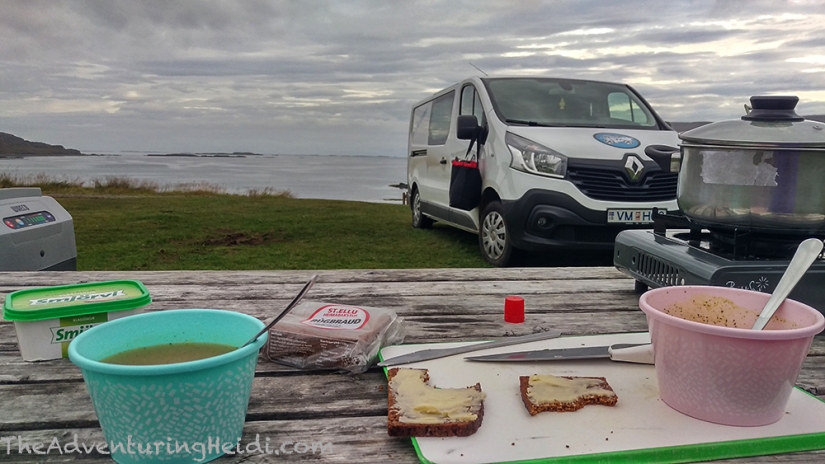
The van did come equipped with an electric cooler, but we found it really didn’t keep stuff very cold. We had packed an insulated cooler bag from home which we put half of our “cold” items in. At night we would place both the cooler and insulated bag outside, which kept things nice and cold, especially since the cooler only runs when the vehicle is turned on. Just something to note before buying anything frozen (it’ll thaw quickly), and to take in consideration with refrigerated goods.

Also, be careful with cartons of eggs, because it really sucks to have broken eggs inside your cooler with all your food… ahem.
Examples of meals we had included sandwiches, variety of soups, spaghetti, beef steaks, chicken cordon bleu, baby potatoes for side dishes, horse steaks (this was a happy accident), carbonara, burritos, and hot dogs. Breakfast was often Cheerios or muesli, skyr, and fruit. Snacks included variety of veggies (carrots, cherry tomatoes, baby sweet peppers), Hraun bites (my favorite!), Rís Buff, pretzel sticks, paprika flavored Lays chips, chocolate bars, apples, and bananas.

Fueling Up
Carl ran on diesel, which is cheaper than gasoline in Iceland (opposite of the U.S.). The van was very fuel efficient for its size, and barely sipped the fuel, even when we had the van idling for extended amounts of time – it averaged somewhere in the 30 miles per gallon!
We fueled up a total of 8 times during our 19 day, 3669km/2300mile trip, and never really let the fuel gauge get too far below half a tank. One thing that I really noticed as an American is that gas prices did not vary very much throughout all of Iceland – quite the contrast to the U.S., where two gas stations across the street from each other can be significantly different in price!

Here’s a breakdown, based on the September 2018 exchange rate to USD from my credit card statements:
Total: $590.65
Fuel Schedule:
Day 4 – Mosfellsbær – $54.74
Day 6 – Stykkishólmur – $87.04
Day 8 – Ísafjörður – $67.59
Day 10 – Blönduós – $74.87
Day 12 – Myvatn – $63.78
Day 13 – Egilsstaðir – $70.91
Day 17 – Kirkjubæjarklaustur – $91.68
Day 19 – Hafnarfjörður – $80.04
In order to use unmanned gas stations (which are fairly common in more remote areas… which is most of Iceland), or to avoid having to go inside, you must have a 4-digit PIN number to enter and have a chip card. Most American credit cards do not assign PIN numbers, and some that will assign them will take it as a “cash advance” transaction, which can have crazy high interest rates associated with it. A solution for this is to use a debit card, which naturally have PINs with them, but the downside is you aren’t buying things on credit then (you have to have the money in your account) and sometimes large holds can be placed on the card, which will tie up any available money. Another solution is many travel-associated credit cards will assign PINs that will work as a normal transaction. I have a Bank of America Travel Rewards card with PIN that I used almost exclusively in Iceland, and it worked flawlessly at every gas station. I also had an REI Mastercard with a PIN, and my credit union debit cards. Also, a few weeks before I departed I notified the companies/credit unions of all the cards I was bringing of upcoming international travel. Oddly enough, the Bank of America Travel card started declining starting at KuKu Campers, even though I had a travel alert for Iceland set on it. I was able to resolve this by going on the app on my phone and confirming that yes, indeed I was in Iceland, and yes, I really did want to spend all that money.
Other quirks to getting fuel is that in Iceland, gasoline pumps have green handles, and diesel will have black. This is opposite from the United States, but they make it really obvious which one you’re selecting so there is no excuse to mess this up!
Another bonus… many gas stations in Iceland have free car washing stations that you can use. This is helpful, as vehicles get dirty quickly from the rain and/or gravel roads. Some will have coin-operated vacuums, which are handy if you must clean your vehicle before returning (this was the case with KuKu Campers, unless we wanted to pay a cleaning fee).
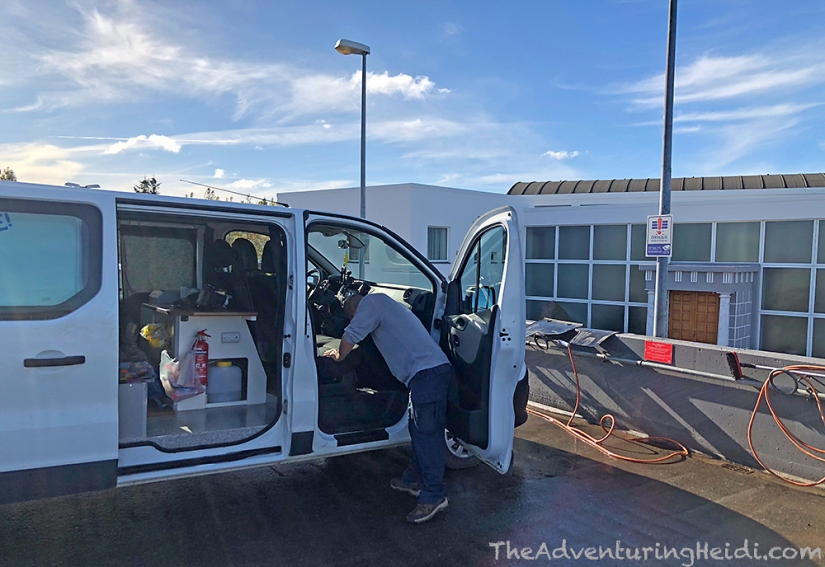
Camper Van Living Situation

Carl was equipped with a table and bench seating in the back which converts to a sleeping area. Kubo and I opted to leave it in bed mode for the duration of the trip, as this was convenient and because there were only two of us, we had room to use the counter by the sink as our table for meals that we ate inside the van. Underneath the bench seat cushions is ample storage space, so on the passenger side of the van we stashed our clothing (which were all organized into various packing cubes, making it easy to locate exactly what we needed), and on the driver side we used it as our pantry for all our dry food goods. During the day we would fold up our sleeping bag towards the rear.

In the rear, there is storage space for some luggage, where we put one of our larger bags that we checked on the place, and smaller carry on. Underneath the bed space we placed our other luggage bags, the rented chairs, and camera tripod. I’d shove our dirty laundry bag under there, too.

For sleeping we used a Kelty Double Wide 20 degree double person sleeping bag, which kept us warm in the September weather. We also brought camping pillows from home that compress down for packing. Our coldest night was 1°C/34°F, but we survived without using the heater overnight.
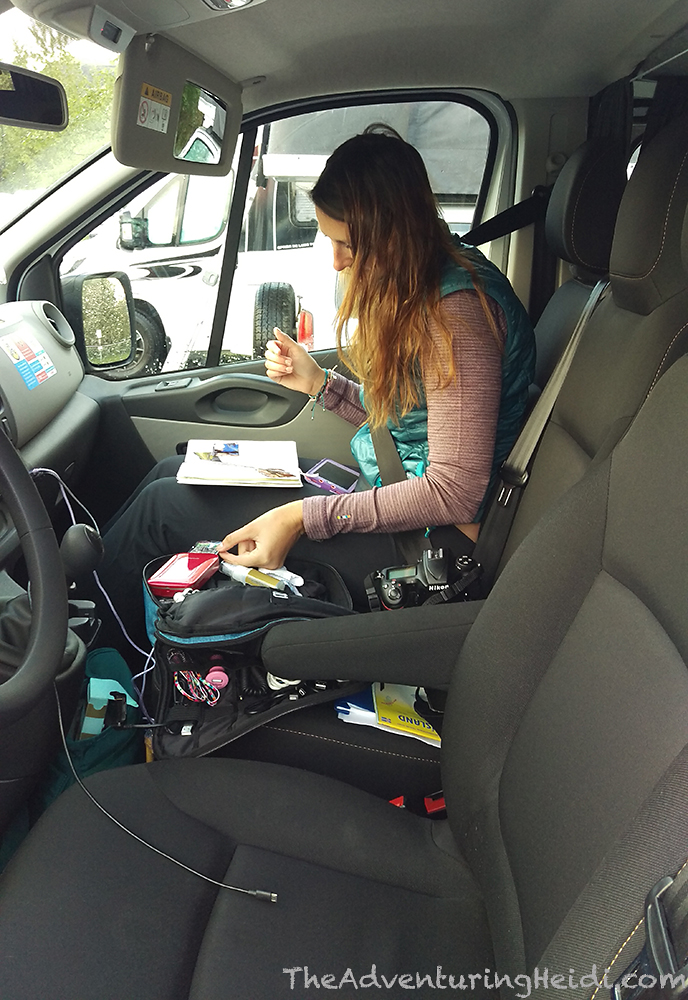
The van came with plates, bowls, cups, pot, frying pan, silverware, knives, spatulas, ladles, cutting board, camping stove, broom and dustpan, and a box of entertainment items. We bought dish soap and paper towels to round out our kitchen. Everything to cook simple meals!

Packing Tips
First off, be mindful of the space you will have in the van. One of the reasons we picked a larger size van is so we wouldn’t have to shuffle luggage around every night in order to have room to cook and sleep. Because of the length of our trip (19 days), and some of the items were were bringing (hiking poles, sleeping bag, pillows, etc), we had two checked bags, two carry on roller bags, and two backpacks.
- Many campgrounds have laundry facilities. This can help cut down on how much you have to pack
- I said this earlier, but packing cubes! They make van life simple and organized. Your items will be quick to find, and stay orderly. I had packing cubes for socks, underwear, base layers, toiletries, etc.
- Pack zip lock baggies in various sizes! We found these oh so useful for everything from leftovers, to storing open sandwich meat, packing out wet swimsuits during hikes like the one to Reykjadalur (“hot river”), bringing home jam, etc. We had both quart and gallon sized bags.
- Don’t forget bags for trash and dirty clothes.
- A quick drying towel is great for both showering and hot springs
- Clothesline/small rope! We strung a piece across the back of the van on the inside, and hung out towels to dry, swimsuits, and even laundry when we had a snafu with the dryer. Also good for hanging up rain gear that needs to dry out.
- Face wipes (I like Burt Bees brand personally) and baby wipes are great for freshening up when unable to shower, and cleaning up messes that may happen.
- Flip flops/sandals are good for hot springs (especially of the natural variety), running quickly to the restroom at the campground, and even for warm days – seriously, I wore my Chacos an entire day in September on Snæfellsnes!
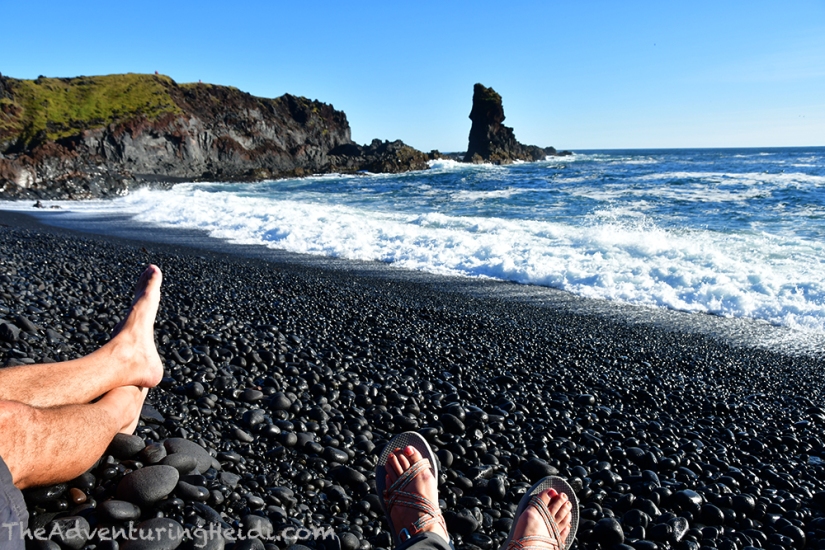
- Refillable water bottle is a must! Iceland’s tap water is safe and great tasting, and you can also fill bottles in most fast moving rivers. I opted to use a 40oz Hydroflask. Along these lines, Kubo and I both brought coffee mugs.

- Electrical outlet plug adapters (if needed) – needed if you’re from the U.S., not needed if you’re from Europe. I bought a 3 pack cheaply off Amazon.
- Inverter to charge electronics in the van. I bought this in the U.S. since my DSLR camera battery chargers are U.S. plugs. It was a simple Stanley brand inverter, and worked great to charge up the DSLR, GoPro, and laptop as we were driving down the road. I have three batteries for my DSLR, so I was able to rotate them to make sure I always had a fresh one. The Stanley inverter also had a USB plug, so I could use that for my cell phone as well. The van had some USB charging ports as well. Kubo and I had no problem keeping two cell phones and all my camera equipment charged with what we had available.
- Don’t forget a tripod if you’re traveling during Northern Lights season!!
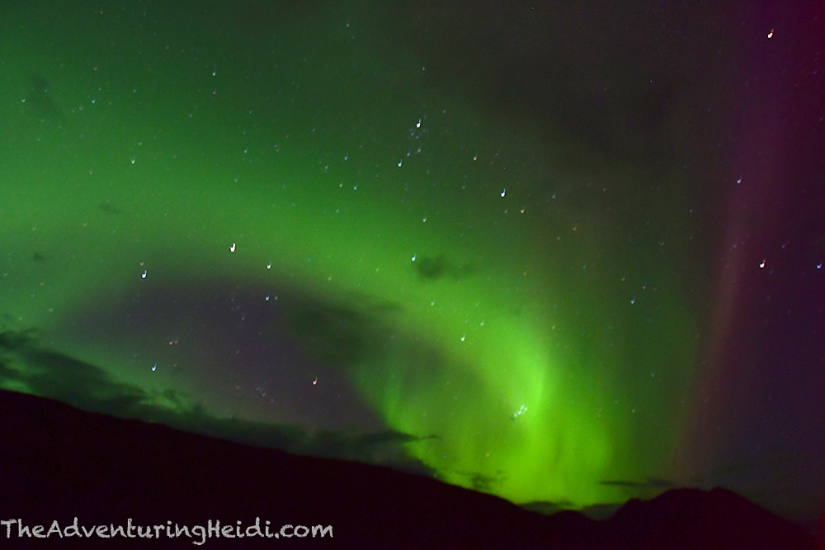
One thing you will not see me recommending is packing a ton of food from home. There is no need for this, unless you have a very strict diet due to allergies perhaps. Grocery stores are found all over Iceland. All we brought from home was protein bars and tea, and guess what? We brought nearly all the protein bars and tea back home. Heck, I actually brought a decent amount of food back home with me that I fell in love with in Iceland – Maggi soup mixes, teas, snack items, homemade jam, etc.
I also packed a lot of hair products, which I never touched aside from shampoo and conditioner. Now, I’m a bit more of an outdoor, natural type of girl, so I wasn’t overly concerned with how my hair looked, and I rarely wear more than mascara so beauty products weren’t a huge deal for me. I will recommend waterproof mascara because of the rain and soaking in hot pots. I did bring an international travel sized hairdryer with me that I could switch to the Icelandic voltage, and use with a plug adapter, and used it a handful of times. Really probably wasn’t necessary in the grand scheme of things, considering I had better things to do than spend time in a bathroom fixing my hair up that would get rained on two minutes later.

Free Shelves
Many of the campgrounds and camper van rental headquarters have “free shelves” where other travelers have left their leftover food and other items for others to take. Utilize these! At KuKu we grabbed some spices and oil, and at one of our first campgrounds, some foil to wrap burritos in. The king of all free shelves is at the Reykjavík campground, which has an extensive collection of discarded items for others to use. You can find dry food goods, paper towels, toilet paper, spices, cooking oil, etc. I know we definitely contributed a lot of items on our final morning! The Reykjavík campground is definitely good to hit up if possible at the beginning of your trip. Do not feel ashamed about pillaging these free shelves, as they get restocked constantly by travelers, and it’s all there so things are not wasted!
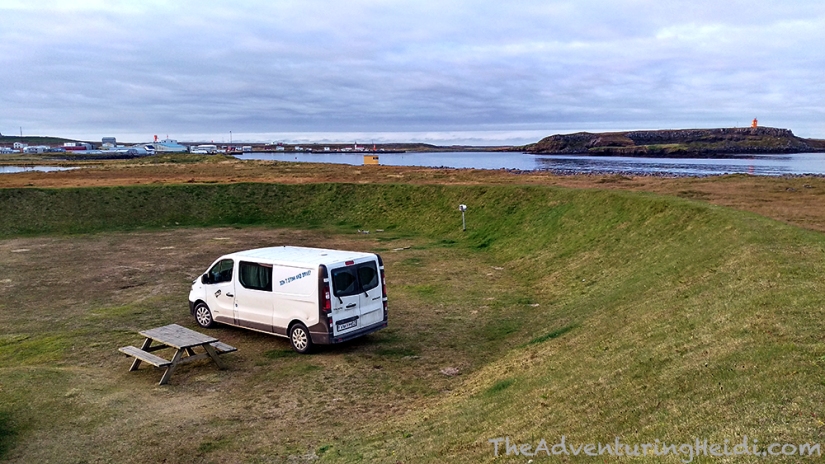
Driving in Iceland
I feel like I need to preface this, as Kubo and I tend to have a polar opposite opinion of Iceland’s roads compared to many other travelers. Both of us race cars and are driving enthusiasts, so we ate up the narrow, often gravel, roads that Iceland threw at us, and loved every minute of it. However, I understand that not everyone will be as comfortable on Icelandic roads, or even enjoys driving period.
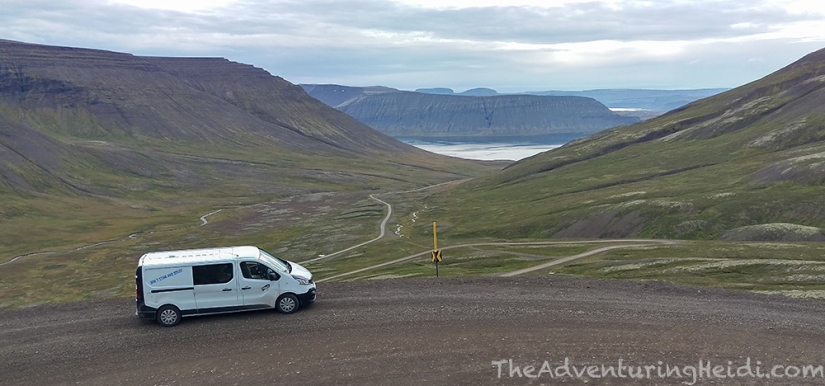
Speed limits are lower than what one would find the United States, especially out west like where I am from. They are enforced by speed cameras, but Iceland is very lovely and gives you warning that speed cameras are coming up… no excuse to get a ticket! The speeding fines are very expensive in Iceland, and you’re still expected to pay even if you leave the country. To boot, many rental companies will also charge you a handling fee for forwarding tickets to you. Because of the narrow roads, and twists, curves, and hills, Kubo and I both agreed that the speed limits were reasonable and 56mph was not as slow as we had initially thought it would feel on the Ring Road.
Main highways, like the Ring Road (Road 1) have a speed limit of 90km/h (56mph), with speeds reducing as you enter towns. Populated areas have speed limits of 50km/h, with residential areas having 30km/h limits. Gravel roads have a speed limit of 80km/h.

Icelandic sheep roam wild and crazy everywhere, and they’re quite suicidal so you must always be paying attention for them, and if seen, don’t expect them to run away from your vehicle. If you hit a sheep, you have to pay the farmer for it, and this can be quite pricey. Don’t trust those shady animals one bit!

Many bridges are one-lane in Iceland – in fact, it gets weird when you come across one that is two-lane. Simply, the person who reaches the bridge first proceeds, and the car on the other side waits. Some bridges, like the one over Sulá in south Iceland, is long and you can’t see all the way to the other side. Therefore, there are pull offs on the bridge in case you encounter a car.

Along the same lines, there are one-lane tunnels in Iceland as well, primarily in the Westfjords and Tröllaskagi peninsula. I had stressed slightly about these, but it turns out that if you have the pull offs on your side, you’re the one who has to yield. We ended up enjoying the tunnels a lot… it was an adventure! Some tunnels have speed cameras in them, so don’t use tunnels as an opportunity to pretend you’re a race car driver.

Most vehicles, from tiny cars to camper vans, in Iceland have manual transmissions. Automatic vehicles tend to be pricier and need to be reserved much farther in advance since there’s not as many of them to go around. I’ve been driving a manual all of my adult life, and I strongly believe Iceland is not the place to be learning how to drive a manual transmission. If it’s not one of your skills, then opt for an automatic. The roads are steep and challenging.
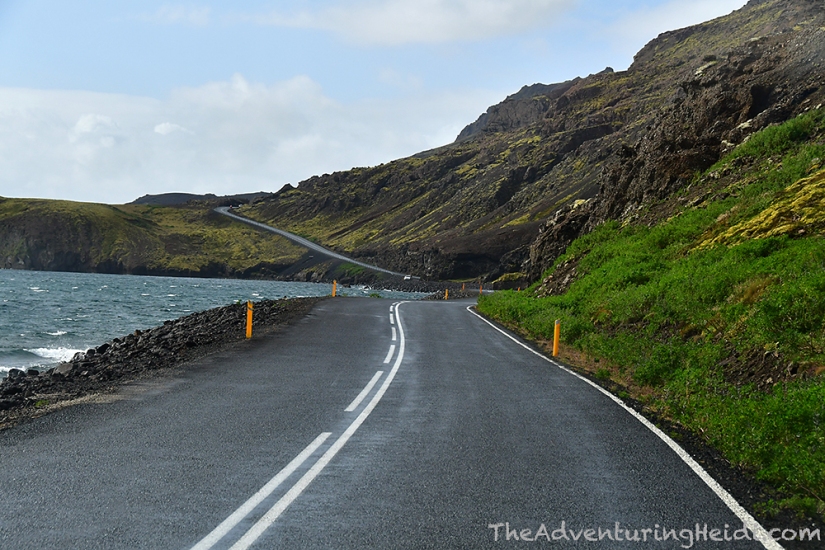
Overall, we enjoyed driving in Iceland. But it takes some care. Do not stop in the middle of the Ring Road to take photos, as much as it might tempt you. There are no shoulders on nearly all the roads, but there are many pull offs, driveways, etc, where you can safely stop. The roads are curvy, twisty, steep, narrow, have blind hills, and often have no guardrails. Iceland is amazingly beautiful, but drivers need to remain attentive, especially when there’s people stopping in the middle of the road for photos and suicidal sheep running around.

- Road 917 in the eastern fjords
Road Trip Tips
- Though we did listen to Bylgjan 98.9 a fair amount (Top 40 station that played music we knew, but otherwise was all Icelandic), Kubo and I both played music from our phones over Bluetooth from Spotify. I had compiled a decent road trip play list of songs from The Secret Life of Walter Mitty soundtrack, Of Monsters and Men, Ásgeir, One Republic, and many others. Kubo’s phone has a crazy weird mixture of music from metal to Backstreet Boys (oh yeah, I’m publicly putting that out there!) to techno to pop. Good playlists keep things fun, and can lead to funny Wilson Phillips karaoke moments.
- I used Google Maps on my iPhone for navigation. I paid for Verizon’s TravelPass on my phone plan, which cost $10/day and gave me my data and phone plan from the U.S. I found the 3G/4G LTE service to be fairly good in most places we went, with obvious lack of service in steep canyons and the highlands. We had really good luck with Google Maps, but it’s important to note that many places in Iceland share a name with other locations, so when inputing places make sure you’re selecting the right one (for example, there’s several villages named Vík). I did bring along a paper map, which was handy for finding landmarks.
- Have a general itinerary, but don’t be afraid to explore new things as you find them. Iceland has amazing signage, and you’ll find signs for sights that you didn’t even know existed. Sometimes the random parking lot will lead you to awesome hidden spots! The symbol ⌘ on signs indicates an attraction, point of interest, etc.
- Put passengers in charge of snapping photos while driving. Seriously! We came away with almost 10,000 photos, and a good majority of them I took from the passenger seat while we were cruising down the road. You’ll be surprised of the great shots you can get… and it helps alleviate having to find places to stop on the narrow roads.
- You can avoid paying for a handful of minutes of hot water for showers at some campgrounds by utilizing the town’s swimming pool for only a little extra money. The swimming pools in Iceland are wonderful, and for the entry price you’ll get to soak/swim in gloriously warm water, and then get your shower out of the way. Though we tried to stay in campgrounds with free showers, we used the swimming pools in Hofsós and Selfoss to get our hygiene needs out of the way.
- We took the Ferry Baldur from Stykkishólmur (on the Snæfellsnes peninsula) to the Westfjords, which saved us hours of driving (and all that diesel). The ferry for the van, Kubo, and I was 15,420 ISK (less than $130USD with current exchange rate). We felt that this cost was justified, and we enjoyed getting to our campsite in Flókalundar early enough to relax during dinner, pick bilberries, and then enjoy sunset and a long soak at Hellulaug. Something to consider if the Westfjords are in your itinerary (the ferry runs both directions), and want to cut down on some driving, or at least want to limit your time on the infamous Westfjords gravel roads.

Final Thoughts
Kubo and I really enjoyed van life in Iceland. It was perfect for how we wanted to travel. So much so, that we plan on doing it all again in the winter! We do want to return in the summer for a highlands trip as well, but most likely will not rent a camper van due to the high cost of 4WD camper vans and the fact the highland routes we want to do involve river crossings that are best done in a more “typical” vehicle, if you will. But hands down, if you’re up for giving up the luxuries of hotels and maid service, maybe don’t care if you get a shower every day, and don’t mind eating simple meals, a camper van is the best way to see Iceland!

Kubo really enjoyed the driving experience of Carl. The van was smooth, peppy, and easy to drive. He really bonded with Carl, and still to this day says, “I miss Carl” at random moments! If we could’ve fit the van in our suitcase, we would’ve stolen it and brought it home with us! And talk about putting sleeping in a Subaru Forester into perspective… my dear Fozzy feels so tiny to sleep in now.
Our experience with KuKu Campers was pleasant and non-eventful. The vans are practical and simple, which keeps them affordable! Customer service was great, I always got prompt replies to email, and every employee was friendly and helpful while we were at the office. And we really liked the kookiness of KuKu Campers, even if our van was plastered with “Don’t Stink and Drink!”, ha! (I’ll admit, I was a little jealous of the KuKu Camper we saw in the Mývatn area with Dolly Parton painted on the side!)


Some fab tips here, I’ll definitely take them on board for my next road trip!
LikeLike
Thank you!!!
LikeLike